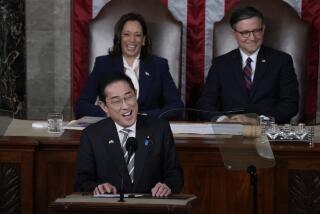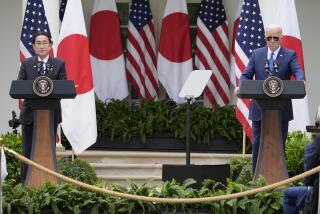Japan Offers $128-Billion Plan to Boost Its Economy
- Share via
TOKYO — In a bid to blast away the deepening financial gloom here, officials on Friday offered details of a $128-billion economic package, including $30.7 billion in short-term tax cuts, that experts agree will spur domestic demand and edge Japan out of recession--at least temporarily.
“This amount of fiscal boost is virtually guaranteed to take the economy off the rocks,” said Richard Jerram, chief economist at ING Barings Securities.
But other analysts questioned whether even this huge, planned public spending will keep Japan’s economy growing once this fiscal fix wears off, whether consumers will stash their tax cuts in the bank and whether taxpayer money will be frittered away on pork-barrel projects that narrowly benefit constituents of the ruling Liberal Democratic Party, or LDP.
“We welcome the substantial policy measures announced today by the Japanese government,” said Robert E. Rubin, the U.S. Treasury secretary and frequent Japan critic who listed several other steps that he wants Tokyo to take. “We hope the government will put these measures into place quickly and effectively and move forward with further actions, including measures to strengthen Japan’s financial system and open and deregulate its economy, to help establish a basis for long-lasting domestic demand-led growth.”
The United States, chary international investors and an increasingly anxious Japanese business elite have been prodding embattled Prime Minister Ryutaro Hashimoto to stop dithering and take dramatic measures to rescue the Japanese economy from a worsening slump that they fear could drag down the sickly economies of Asia and dent U.S. growth.
Eager to avoid another humiliating public scolding when Hashimoto meets President Clinton at the Group of 7 leading industrial nations summit that opens May 15 in Britain, the Japanese Cabinet approved big temporary tax cuts that will average $557 for a family of four and a bonanza of public works spending to get the economy pumping again.
To defuse criticisms that Japan is not doing enough to ease the Asian economic crisis, the package includes $5 billion to promote trade and investment in Asia, atop $40 billion already offered, and food and medical aid to Indonesia.
Also included are $20 billion in spending in long-neglected areas such as environmental protection; a nationwide network of fiber-optic cable; more scientific research; and fresh steps to resolve the bad-loans crisis in the banking industry.
“I urge people to have confidence and a brighter outlook,” Finance Minister Hikaru Matsunaga said. “I hope consumers and companies will become more aggressive.”
But fostering optimism will be a long, hard struggle.
Hashimoto’s public support ratings have plunged to a dismal 37%. Japanese citizens have been voting no-confidence by the millions by saving desperately to protect themselves against an uncertain future. Some are so worried that they are stashing their money in safes instead of banks.
As for financial markets, they shrugged at the Japanese government’s announcement, with the dollar ending at 131.16 yen in New York on Friday, up from 130.18 on Thursday.
Meanwhile, international investors complain that Japan has announced so many disappointing measures since the Asian economic crisis began last year that they are by now numb with “package fatigue.”
“Pessimism has become so congenital . . . and the public relations ability of the authorities has been so poor that even a package of this size has led most people to just yawn,” said Ronald Bevacqua, chief economist at Merrill Lynch Japan Inc.
But this time, “the government has delivered more than what people demanded . . . and it will have an impact on growth,” Bevacqua said.
The package includes $94 billion in direct economic stimulus, or 2.4% of Japan’s gross domestic product, enough to produce 1% to 1.5% economic growth this year, he said.
Vice Finance Minister Eisuke Sakakibara said the package will boost growth to about 2% in fiscal 1998, which ends next March.
But even fans of the package noted that it does not address the severe structural problems that have been corroding the world’s No. 2 economy.
Hiroshi Sakurai, an economist at Kankaku Research Institute, noted that the government has spent about $515 billion to stimulate the economy since 1992, yet “the situation has not changed, or maybe is getting worse.”
Sakurai and others said the government’s first priority should be to solve the festering bad-loan problem. Some believe that the Japanese financial system is being sucked under by a debt vortex much larger than even the $715 billion in bad and risky loans that the government has acknowledged.
In December, Hashimoto announced $230 billion to shore up the banking system, but critics say a more drastic write-off of bad debt is essential.
“They have a [$230-billion] Band-Aid over it, but it doesn’t solve the problem,” Bevacqua said, adding that, if bankruptcies and deflation continue, the tide of red ink will keep rising.
One stumbling block to clearing the bad loans has been gridlock in the Japanese property market.
Tax laws and other regulations have made it disadvantageous to debtors and creditors to sell off land. Friday’s package includes tax incentives to encourage property transactions.
Some business leaders, though mollified by the massive package, said they still want Japanese corporate taxes cut to international levels. Others said the temporary personal income tax cuts--which only last through 1999--should be made permanent.
The LDP is promising a thorough revision of the tax system. But how soon and how substantial the overhaul might prove are unknown.
The $59 billion in public works spending remained the most controversial portion of the package.
“In the short term, it will stop the plunge in the economy, but in the long term it will not lead to a sustainable recovery,” said Tetsuro Sugiura, chief economist at Fuji Research Institute, who predicted that the glow would last but a year.
Eiji Yamamoto, a Konan University economics professor, shuddered at “building more harbors and roads that nobody will really use in remote areas.”
The real purpose, he said, is to help Japan’s notorious lobbyist lawmakers win votes from construction workers in the July parliament elections.
But Richard Koo, a senior economist at Nomura Research Institute, said what matters now is not how Japan spends its yen but only how much it spends.
“Whether it’s a trillion spent on bribes or a trillion spent on an optical fiber network, both are included when we calculate GDP,” Koo said. “When people are so worried, the only measure left is public works. That’s what we learned in the [Great Depression of the] 1930s. When nothing else works, public works works.”
Analysts were generally favorable about the plan to spend $7.7 billion on information technology, including a plan to link schools, hospitals and then homes with fiber-optic cable. Japan lags far behind other leading industrialized countries in personal computer and Internet use, and the government’s goal is to wire homes throughout the nation by 2005--leapfrogging Japan ahead of the U.S.
“The question is whether demand will be there to justify it,” said Richard Kaye, a Merrill Lynch telecommunications analyst who predicted that demand for the high-tech infrastructure might not catch up until 2010.
Etsuko Kawase of The Times’ Tokyo Bureau contributed to this report.
(BEGIN TEXT OF INFOBOX / INFOGRAPHIC)
Reviving Japan
Highlights of Japan’s $128-billion stimulus package:
* $30.7 billion in short-term tax cuts, averaging $557 for a family of four.
* $59 billion in spending on public works.
* An additional $5 billion to promote trade and investment in Asia.
* Food and medical aid to Indonesia.
* $20 billion for environmental protection; fiber-optic cable network; scientific research; and resolving the bad-loans crisis in the banking industry.
More to Read
Sign up for Essential California
The most important California stories and recommendations in your inbox every morning.
You may occasionally receive promotional content from the Los Angeles Times.













